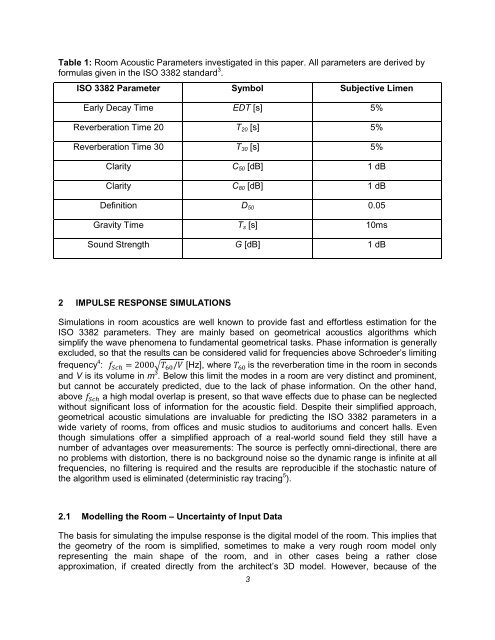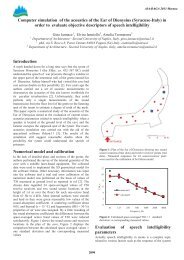paper - Odeon
paper - Odeon
paper - Odeon
Create successful ePaper yourself
Turn your PDF publications into a flip-book with our unique Google optimized e-Paper software.
Table 1: Room Acoustic Parameters investigated in this <strong>paper</strong>. All parameters are derived by<br />
formulas given in the ISO 3382 standard 3 .<br />
ISO 3382 Parameter Symbol Subjective Limen<br />
Early Decay Time EDT [s] 5%<br />
Reverberation Time 20 T 20 [s] 5%<br />
Reverberation Time 30 T 30 [s] 5%<br />
Clarity C 50 [dB] 1 dB<br />
Clarity C 80 [dB] 1 dB<br />
Definition D 50 0.05<br />
Gravity Time T s [s] 10ms<br />
Sound Strength G [dB] 1 dB<br />
2 IMPULSE RESPONSE SIMULATIONS<br />
Simulations in room acoustics are well known to provide fast and effortless estimation for the<br />
ISO 3382 parameters. They are mainly based on geometrical acoustics algorithms which<br />
simplify the wave phenomena to fundamental geometrical tasks. Phase information is generally<br />
excluded, so that the results can be considered valid for frequencies above Schroeder’s limiting<br />
frequency 4 : [Hz], where is the reverberation time in the room in seconds<br />
and V is its volume in m 3 . Below this limit the modes in a room are very distinct and prominent,<br />
but cannot be accurately predicted, due to the lack of phase information. On the other hand,<br />
above a high modal overlap is present, so that wave effects due to phase can be neglected<br />
without significant loss of information for the acoustic field. Despite their simplified approach,<br />
geometrical acoustic simulations are invaluable for predicting the ISO 3382 parameters in a<br />
wide variety of rooms, from offices and music studios to auditoriums and concert halls. Even<br />
though simulations offer a simplified approach of a real-world sound field they still have a<br />
number of advantages over measurements: The source is perfectly omni-directional, there are<br />
no problems with distortion, there is no background noise so the dynamic range is infinite at all<br />
frequencies, no filtering is required and the results are reproducible if the stochastic nature of<br />
the algorithm used is eliminated (deterministic ray tracing 5 ).<br />
2.1 Modelling the Room – Uncertainty of Input Data<br />
The basis for simulating the impulse response is the digital model of the room. This implies that<br />
the geometry of the room is simplified, sometimes to make a very rough room model only<br />
representing the main shape of the room, and in other cases being a rather close<br />
approximation, if created directly from the architect’s 3D model. However, because of the<br />
3
















